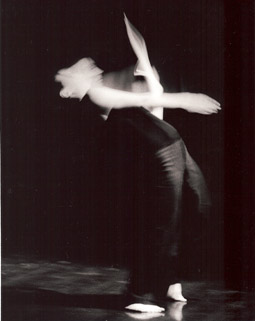nalina wait: making room
yana taylor

Nalina Wait
photo Heidrun Löhr
Nalina Wait
Sounds like the whirring of electro cicadas in the night become audible. The performance begins. On the floor, taut, tilting on her tail like the point of a compass sits a young woman beside a standard lamp. My head rolls in response.
Impulses hit dancer Nalina Wait without warning, minute and then all encompassing. Sudden stillness strikes this body. A subtle trio unfolds between the sounds—the snap of lamp switch or the staccato of thrash guitar soundtrack—unseen features of this room and this dancer’s body. Bit by bit we are made aware of the room as the brief dance progresses; lamp and location gather significance as time passes.
We are in a professional dance studio on a warm Saturday afternoon. The event is a boutique showing for an invited, appraising audience. Simultaneously the aura of night-time, of a domestic space thickens. We are all in both places at once.
Wait heads downstage and abruptly stops, facing us. In unanticipated crescendo, the ceiling-full of arc lights, whose presence had gone unnoticed, splutter to brightness. Their sonic glitches invade her body without warning, radiating through her joints. Nervous energy hurtles through spine, shoulders and hips, propelling her limbs. Stillness interjects, textured with tiny ripples through her neck, lifting her chin. These are an aftershock of frenetic but precise gestures of legs, arms, chest and head.
She waits in suspension, feet grounding her composure. Her stillnesses echo sudden silences in the thrash guitar track, but not in sync. Soft yielding alternates with bracing, strident action. The rasp of inhalation and visible pumping of her pulse become prominent in the silences. Her gaze returns gently to a place far beyond us, but her eyes don’t fix on anything. Her focus seems to emanate from her skin reaching around her instead of ahead. Eruptions from places within, like buttons pressed, trigger reverberations of short-term audio memory. The soundtrack ends. Wait’s limbs continue to ferociously carve space about her.
The intermittent battle settles. She is back seated beside the lamp. Not-quite calm returns with the darkness.
Nalina Wait, without a shred of didactic intent, has gently inducted the audience into the work’s vocabulary, sharing how her body was surprised, shocked in the ravelling and unravelling. There were hints of emotional reaction to matters close and far away alongside items of the everyday—home interiors and clothing. These could suggest a narrative. However, the relationship between a hovering backstory and Wait’s intense labile engagement with the materiality of the actual setting was ambiguous. In this gap, there was space for our bodies to be caught up in the visceral flow or to elicit memories and sensations of other rooms.






